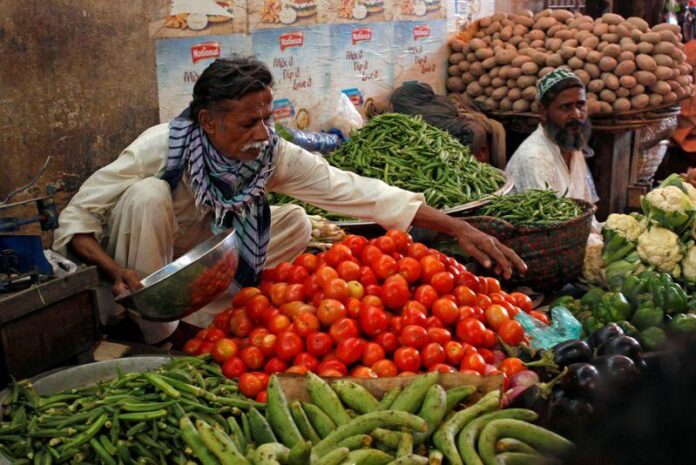–Highest recorded inflation since PTI took office in August 2018
–Analysts say inflationary pressure will ease in few months
KARACHI: The inflation rate has jumped up 14.56 per cent year-on-year (YoY) for the month of January, according to data released by the Pakistan Bureau of Statistics (PBS) on Saturday.
This is the highest level that inflation has ever hit since the current government of Pakistan Tehreek-e-Insaf took office in August 2018.
In its monthly report, the PBS noted that inflation had risen by 1.97pc compared to December 2019. This is a marked increase from the previous month’s inflation rates. December’s inflation rate stood at 12.63pc, while the November inflation rate was recorded at 12.67pc.
According to the data released, the bulk of the inflation was linked to rises in food prices, with food and non-alcoholic beverages making up 34.5pc of the CPI. Housing, electricity, gas, and fuel made up 23.63pc of the CPI.
On a whole, the information is dismal: on a YoY basis, tomato prices increased 157.72pc in urban areas, and 211.18pc in rural areas; onion prices increased 125.32pc in urban areas, and 136.63pc in rural areas; fresh vegetables prices increased 93.6pc in urban areas, and 104.47pc in rural areas; potato prices increased 87.3pc in urban areas and 111.24pc in rural areas; and what prices increased 36.13pc in urban areas and 32.18pc in rural areas.
Additionally, gas prices rose 54.84pc YoY in urban areas, and motor fuels rose 25.69pc in urban areas and 26.4pc in rural areas.
However, on a month-on-month (MoM) basis, tomato prices decreased 8.36pc in urban and 8.22pc in rural areas, while onion prices also saw a decrease from December 2019 (18.37pc in urban and 20.52pc in rural areas).
This unusually high inflation rate of 14.56pc stands in sharp contrast to the official line the State Bank of Pakistan (SBP) is promoting.
It also puts the SBP in trouble, as the IMF’s [Intenational Monetary Fund] had given strict instructions to maintain positive real interest rates (nominal interest rate minus inflation rate). The real interest rate has for the first time dipped into negative territory, at -1.35pc.
In the most recent monetary policy announcement on January 28, the SBP said that the bank’s projected average inflation for FY20 has remained broadly unchanged at the (much lower) 11-12pc range.
“The MPC viewed the latest increase in CPI [Consumer Price Inflation] as primarily transitory in nature,” the central bank said in a statement.
While noting that the recent inflation outruns of November and December 2019 had been on the higher side, the SBP maintained the figures reflected “sharp increases in selected food items on account of temporary supply disruptions and upward adjustments in administered prices”.
Terming the recent food inflation as ‘supply-side shocks’, the statement said that the “second rate effects on inflation from supply-side shocks have not materialized, and inflation expectations remain broadly anchored”.
In addition to supply shocks, analysts term this spike in inflation also due to the lag impact of devaluation of Pakistani rupee.
In fact, SBP Governor Reza Baqir somewhat optimistically said inflation would be brought down to 5-7pc over the next two years.
AKD Securities noted in a research report sent to clients on January 29: “The [SBP] policy statement carried ‘accommodative bias’, with the statement downplaying inflationary risks, in our view. The central bank has surprisingly kept its inflation forecast for FY20 unchanged at 11-12% despite the recent increases in food prices, which we think are relatively broad-based and non-cyclical in nature barring an increase in wheat and its byproducts prices.”
January’s inflation rate crossed even expectations of what market analysts were predicting, at around 13-13.6pc.
“Going forward I expect food inflation to persist at least till Ramzan that can keep inflation elevated, after which the base effect will come into play in pulling down inflation numbers,” said Hamza Kamal, analyst at AKD Securities.
Arsalan Hanif from Arif Habib Limited said inflationary pressures will ease in the upcoming months. “The government allowing the import of wheat will most likely normalize prices,” he said. He also said a significant decline in prices of perishable goods will bring inflation down to below 13pc.
At the start of January 2019, the inflation rate was recorded at 5.6pc. It stayed in single digits until August 2019, when the inflation rate was recorded at 10.5pc. It then hovered between the 11-12pc range from September to December 2019, before climbing to 14.56pc in January 2020.
In Pakistan, inflation is measured by the Consumer Price Index (CPI), using the base year of 2015-16. The PBS changed the base year for price statistics in August 2019, from 2007-08 to 2015-16.
The CPI comprises urban CPI and rural CPI. The urban CPI covers 35 cities and 356 consumer items.
The rural CPI covers 27 rural centres and 244 consumer items. In the new base year, the CPI for 12 major groups is also computed by taking the weighted average of urban CPI and rural CPI.
Additional reporting by Ariba Shahid.


























Interestingly the rupee is appreciating against the dollar in this high inflation environment. What a strange situation we are in!